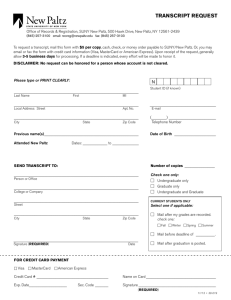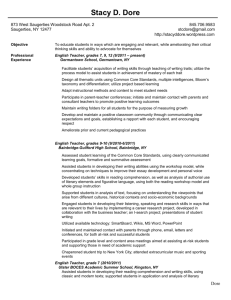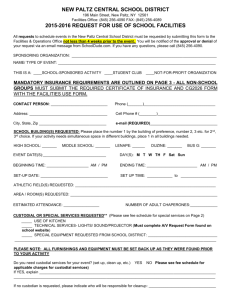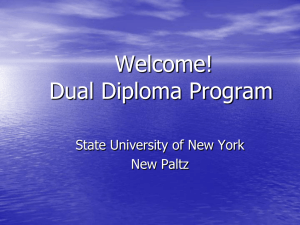Statement in support of amendment proposed by the Faculty of the
advertisement
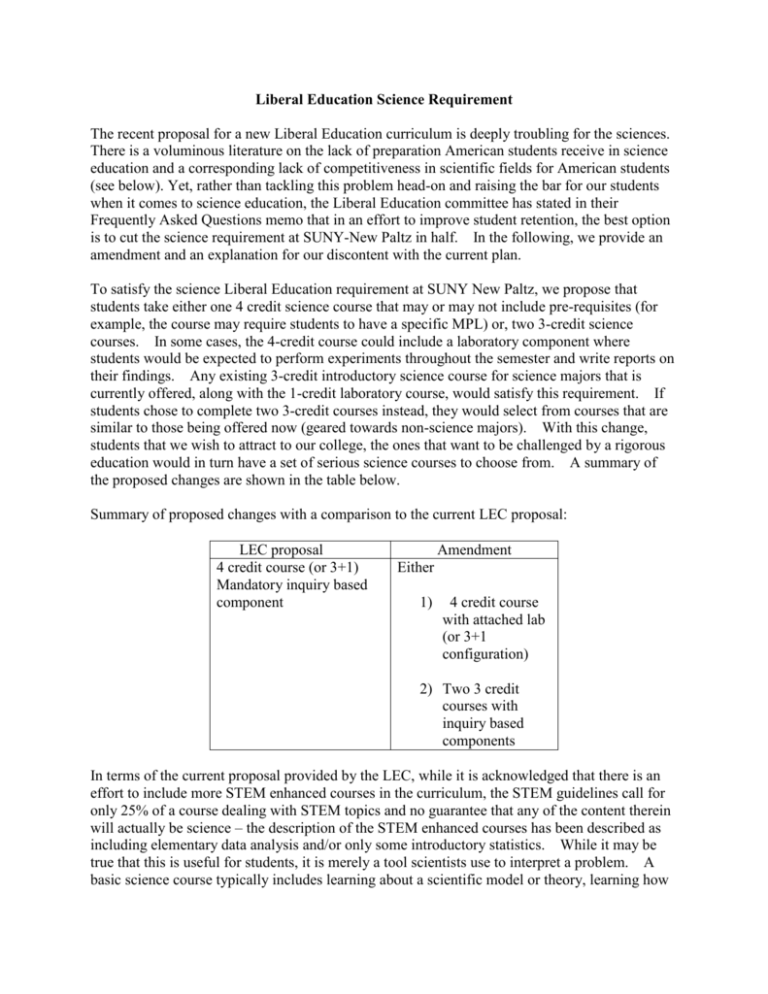
Liberal Education Science Requirement The recent proposal for a new Liberal Education curriculum is deeply troubling for the sciences. There is a voluminous literature on the lack of preparation American students receive in science education and a corresponding lack of competitiveness in scientific fields for American students (see below). Yet, rather than tackling this problem head-on and raising the bar for our students when it comes to science education, the Liberal Education committee has stated in their Frequently Asked Questions memo that in an effort to improve student retention, the best option is to cut the science requirement at SUNY-New Paltz in half. In the following, we provide an amendment and an explanation for our discontent with the current plan. To satisfy the science Liberal Education requirement at SUNY New Paltz, we propose that students take either one 4 credit science course that may or may not include pre-requisites (for example, the course may require students to have a specific MPL) or, two 3-credit science courses. In some cases, the 4-credit course could include a laboratory component where students would be expected to perform experiments throughout the semester and write reports on their findings. Any existing 3-credit introductory science course for science majors that is currently offered, along with the 1-credit laboratory course, would satisfy this requirement. If students chose to complete two 3-credit courses instead, they would select from courses that are similar to those being offered now (geared towards non-science majors). With this change, students that we wish to attract to our college, the ones that want to be challenged by a rigorous education would in turn have a set of serious science courses to choose from. A summary of the proposed changes are shown in the table below. Summary of proposed changes with a comparison to the current LEC proposal: LEC proposal 4 credit course (or 3+1) Mandatory inquiry based component Amendment Either 1) 4 credit course with attached lab (or 3+1 configuration) 2) Two 3 credit courses with inquiry based components In terms of the current proposal provided by the LEC, while it is acknowledged that there is an effort to include more STEM enhanced courses in the curriculum, the STEM guidelines call for only 25% of a course dealing with STEM topics and no guarantee that any of the content therein will actually be science – the description of the STEM enhanced courses has been described as including elementary data analysis and/or only some introductory statistics. While it may be true that this is useful for students, it is merely a tool scientists use to interpret a problem. A basic science course typically includes learning about a scientific model or theory, learning how to apply it in order to solve a problem, and then re-evaluating the theory more critically to determine if/when exceptions might exist. Substituting only the tools in place of a basic science course will not help to teach students how to evaluate problems critically. We do hope that faculty will continue to include some science and math in the courses they teach, where appropriate, in much the same way that courses in the sciences will continue to include components of writing and oral communication. Unfortunately, the decreasing STEM requirements proposed by the LEC is nothing new, but part of a longer-term erosion of these requirements at SUNY-New Paltz over the past couple of decades. In 1993 when GEII was put into place, the science requirement included either two lab courses or three non-lab courses, for a total of 8-10 credit hours. In 2003 when GEIII was put into place, the science requirement was reduced to a minimum of two non-lab courses for a total of 6 credit hours. In the current proposal, the number has been reduced to one course, with no requirement that the sole science course incorporate a lab, for a total of 3 credit hours. On top of the concerns that we feel for the state of science education in and of itself, there is also the question of where the LEC proposal places SUNY-New Paltz in the larger collegiate landscape. There has been much discussion over the past few months over the College Board’s “Admitted Student Questionnaire PLUS” survey and the results have shown that New Paltz struggles to compete for the best students it accepts due, in part, to a perceived lack of rigor and competitiveness. Thus, when the one SUNY comprehensive that ranks ahead of us, SUNY-Geneseo, maintains a two course science requirement, one has to wonder if we will ever make up any ground in creating a rigorous and competitive curriculum for our students. At a time when the state of science education in the United States is struggling, and at a time when SUNY-New Paltz is struggling to be more competitive in attracting the best students, the Liberal Education proposal that continues to water down the expectations for scientific knowledge at SUNY-New Paltz is not what this institution needs to move forward in the 21st century. Science Education Backgrounder National Science Foundation report on the state of scientific knowledge in the United States and the most recent release from 2012 contains some alarming statistics. • Over 25% of American adults believe that the Sun revolves around the earth. • Over 45% of Americans adults believe that antibiotics kill viruses. • Over 50% of Americans believe that humans did not evolve from earlier species. • Over 50% of Americans believe that lasers are highly focused sound waves. • Over 60% of Americans believe that the universe did not begin with Big Bang. The literature on the failings of the United States educational system at the K-12 level is voluminous and educational leaders - as well as politicians and the business community - have decried the lack of American competitiveness in math and science. Perhaps the best comparative measure for scientific learning among students is the Program for International Student Assessment (PISA) that measures the learning of 15 year olds from selected countries around the world. Because PISA is run by the Organization for Economic Cooperation and Development, it is primarily advanced nations that are compared. Among the 34 OECD members in the PISA study, the United States ranks 20 out 34, slightly below average. That puts the United States ahead of countries like Mexico, Greece and Hungary, but well behind leaders like Japan, Korea, Finland, Canada and the Netherlands. Other studies of American preparation in math & science are even more alarming. The World Economic Forum’s “Global Competitiveness Report” from 2010-2011, ranking the quality of American math and science education, placed the United States 52nd in the world, which is typical of many such studies. The lack of preparation of American students in math and science is clearly seen in the ranks of college programs around the country. The OECD study from 2009 found that the United States ranked 27th among developed nations in the proportion of college students receiving undergraduate degrees in science or engineering. In fact, were it not for the fact the over half the graduates students in STEM related fields were from abroad, as a recent study from the Task Force on the Future of American Innovation has found, the United States would have already lost much of its global competitiveness in STEM related fields.
